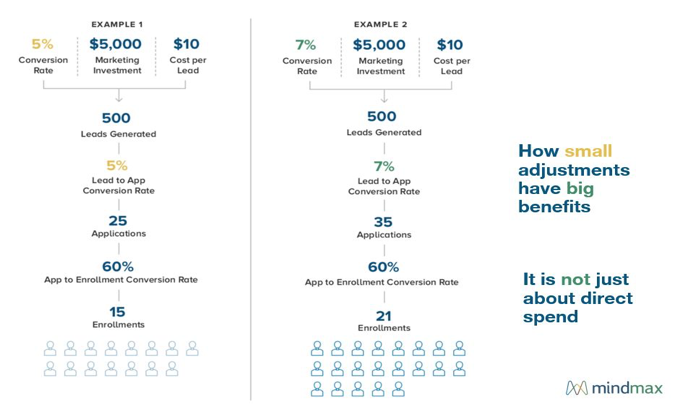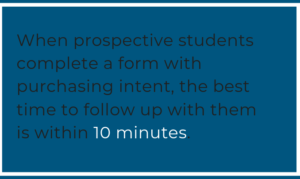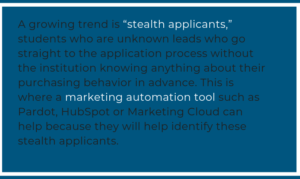Five Enrollment Process Improvements for Growth
Improving your enrollment process can generate a substantial increase in enrollments
There are many components of a successful institution and one of the most critical is the success of its enrollment program. Take into account that adult learner enrollment has slowed down significantly in recent years (by 1.5 million since 2011), and the challenge to enroll this particular group is at an all-time high.
Institutions of all sizes and marketing maturity levels can benefit from re-evaluating their enrollment and marketing strategy. We’ve found that by focusing on key components with small, realistic changes in mind, institutions can see a big benefit.
Here’s an example of how making a small adjustment of just two percent in the lead-to-app conversion rate resulted in six additional enrollments:

What we’ve gained from our experience in bridging the gap between universities and adult learners, is that there are certain parts of the enrollment process that can be adjusted to produce better results. Here are 5 key ways to improve your enrollment process:
- Make sure your lead forms are concise
- Use live chat to improve user experience and generate leads
- Optimize your lead nurturing email campaigns
- Streamline your application process
- Develop a coordinated outreach communication plan for admits
1. Make sure your lead forms are concise
The average website-visitor-to-form-fill conversion rate is 3%-5%. If your numbers are lower than that, start by assessing the number of questions you’re asking on your lead forms.
One of the biggest considerations to reflect on is why you’re asking website visitors for specific information. Just because you can ask the question doesn’t mean you should. The more questions you ask, the more likely you’ll push respondents away.
 Make the process easy and enticing by asking for minimal information such as a first name and email address. In later touch points (e.g., email and retargeting), you can gather more information.
Make the process easy and enticing by asking for minimal information such as a first name and email address. In later touch points (e.g., email and retargeting), you can gather more information.
Lead form best practices:
- Limit fields to essential information – first name and email (only) are ideal
- Place forms above the scroll
- Use directional cues calling attention to the submission button
- Write compelling copy and calls to actions (CTAs)
- Integrate forms to your marketing automation tool – this should not be manual
2. Use Live Chat to improve user experience and generate leads
Live chat is a great way to help move prospective students along the enrollment funnel and generate leads. We’ve found it to be incredibly powerful because people who engage in live chat do so at a similar conversion rate as people making an inbound phone call. It’s an indication that someone is interested (i.e., has purchasing intent) and therefore it’s worth investing more resources and effort for this tactic.
Especially if your chat inquiry is a high-priority request indicating intent to enroll, the sooner you make the follow-up calls the better. In other words, the longer you wait to make follow-up enrollment calls, the less likely you’ll convert the prospective student over.
3. Optimize your lead nurturing email campaigns
An effective lead nurturing strategy can help progress prospective students along their enrollment journey. When creating email sequences, we follow the school’s mission to engage with prospective students and make sure we’re respectful, timely, and relevant. We encourage you to do the same always keeping a student-centric approach.
Key points to consider when optimizing your lead nurturing email campaigns:
- Timing – what time of the day or night are you sending emails
- Frequency – not too frequently or you risk harassing them, not to infrequently or they will move on
- Open rates – if poor, test subject lines
- Click-thru rates – if weak, test content
- Successful emails – analyze the types of email that have the highest open/click-thru rates and replicate your findings across other emails
4. Streamline your application process
Overall, streamlining the application process will help conversions but you’d be surprised at how quickly it can get complicated. For example, as part of one school’s international student application process, the institution asked for social security numbers. The only problem is that international students don’t have social security numbers. If your application process is causing frustration to future students, you risk losing them.

Ask yourself these questions:
- Have you provided all the necessary information prospective students might need?
- Have you removed any barriers for someone attempting to apply?
- Is your process easy to understand for your intended audience?
- Can applicants complete the application in their preferred style of communication?
5. Develop a coordinated outreach communication plan for admits
Congratulations! You worked hard to get prospective students to the admits stage, but you’re not done yet. Of all the stages, this is the most critical. You have already invested a considerable amount of resources getting to this point. Devote the additional time and resources needed to convert applicants to enrolled students. One way to do so is by creating a scalable white-glove experience via a coordinated, multi-channel communication plan:
- Include outbound calling as part of your outreach
- As part of the call, include a message such as, “Congratulations on your acceptance, I’m calling to answer any questions you might have about the program.” Here, you will remove any potential barriers with a quick phone call.
- During the call, you’ll find out more about the decision criteria. This is a great market intelligence opportunity. Be sure to collect and share that information.
- Modify any email campaigns at this stage
- Assess the messaging – are you providing useful information about the program? Can you run any promotions for enrolling early?
- Assess the timing
- Assess the frequency
- Assess open rates. If poor, test subject lines
- Assess click-thru rates. If weak, test content (ensure it’s personalized and relevant)
- Retargeting Messaging
- Develop your messaging so it resonates with a group that has already been admitted and makes them excited to be part of the program.
Takeaways
Improving just a few of the most critical tactics can have a big impact on your enrollment process outcomes, especially those with high purchasing intent and those that are at the admits stage. As with any successful program, taking a holistic approach that is student-centric will help guide you to necessary improvements and success.
What are some of your enrollment challenges or success stories? Share below.

